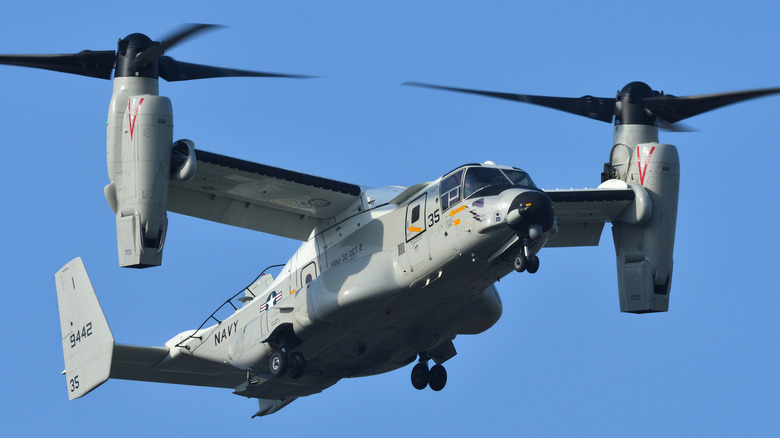What Makes The Bell Boeing V-22 Osprey So Impressive
The Bell Boeing V-22 Osprey tiltrotor is unique within the U.S. military's fleet of aircraft. It was built to replace the aging CH-46E Sea Knight and CH-53D Sea Stallion, both of which were medium-lift helicopters. The Osprey can go twice as fast, six times farther, and carry triple the payload of the Sea Knight.
What makes it a one-of-a-kind aircraft is that the Osprey can function in both short takeoff and landing (STOL) and vertical takeoff and landing (VTOL) scenarios. By tilting its propellers vertically, it can take off and land like a helicopter, but once airborne, the rotors can rotate horizontally and transform the vehicle into a fixed-wing turboprop plane. Thus giving it the ability to land anywhere it wants.
The Osprey first took flight in March 1989 and more than 475 have flown in various missions since. It is considered a joint U.S. service military vehicle, because the Marines, Air Force, and Navy all use different versions customized and kitted to their individual mission parameters and needs. Even Japan's Ground Self-Defense Force (Japan MV) uses them. They have tallied more than 600,000 hours of flight time.
Its versatility allows it to be used in any number of military applications (i.e., infiltration, exfiltration, special operations, resupply, assault) as well as humanitarian missions like disaster relief and search-and-rescue.
Wings of an Osprey
The Defense Acquisition Board authorized production of the Osprey in 2005. A crew of four (pilot, copilot, and two flight engineers) operate the aircraft, and, at over 57 feet long, it can transport up to 24 people.
Two Rolls-Royce AE1107C engines, each producing 6,150 shaft horsepower (shp), provide a maximum speed between 265 and 295 mph, depending on the version. It has a range of 1,100 nautical miles and, when equipped with auxiliary fuel tanks, can fly up to 2,100. Technically, it can stay in the air indefinitely as it has the ability to refuel while flying.
Because its primary purpose is to transport troops and equipment, not to engage in direct combat, the Osprey is only armed with a single .50-caliber machine gun. It's used around the globe, and it has a corrosion-resistant coating that protects it from salt water and other harsh environmental conditions.
Transportation to exotic locations is accomplished in a peculiar way — by folding up the blades so they can be stored in close quarters aboard an aircraft carrier or assault ship. The Osprey is a real-life Transformer and ironically appeared in one of the many "Transformer" movies.
Ospreys are equipped with a litany of advanced systems, including FLIR (forward-looking infrared sensor), threat countermeasures, and terrain-following radar, all of which allow them to function in poor weather and hazardous combat environments successfully. But with Bell's V-280 Valor in development, the Osprey's wings might eventually get clipped.
